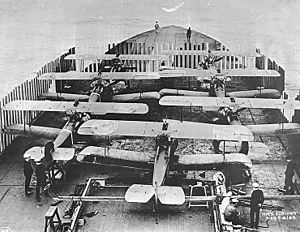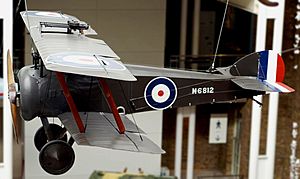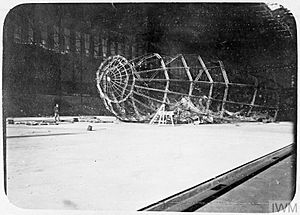Tondern raid facts for kids
Quick facts for kids Tondern Raid |
|||||||
|---|---|---|---|---|---|---|---|
 The seven Sopwith Camels on the flight deck of HMS Furious en route to the Tondern raid |
|||||||
|
|||||||
| Belligerents | |||||||
| Commanders and leaders | |||||||
| None | |||||||
| Strength | |||||||
| 7 aircraft | 2 airships 1 captive balloon |
||||||
| Casualties and losses | |||||||
| 1 drowned 3 interned 1 aircraft damaged 3 aircraft interned 2 aircraft abandoned 1 aircraft lost at sea |
4 wounded 2 airships destroyed 1 captive balloon destroyed 2 hangars damaged |
||||||
| First attack from an aircraft carrier | |||||||
The Tondern Raid, also called Operation F.7, was a bombing attack by the British Royal Navy and Royal Air Force. They targeted a German airship base in Tønder, which was part of Germany at the time (now in Denmark). These airships were used by Germany to bomb Britain during World War I.
This raid was very important because it was the first time in history that airplanes launched from an aircraft carrier to attack a target. On 19 July 1918, seven Sopwith Camel planes took off from the ship HMS Furious. The British managed to destroy two large German airships, called Zeppelins L 54 and L 60, and also a smaller balloon. The British lost one pilot and several aircraft during the mission.
Contents
Why the Raid Happened
In March 1918, the ship HMS Furious joined the main British fleet, known as the Grand Fleet, at Scapa Flow. The Furious was special because it had been changed into an aircraft carrier while it was being built. It had a flight deck at the front for planes to take off.
By 1917, the Furious was using Sopwith Camel 2F.1a planes. These were a special navy version of the Sopwith Camel. Later in 1917, another flight deck was added at the back of the ship. However, landing planes on this back deck was very risky. Before the Tondern Raid, the Furious often went on missions to scout for German minefields.
While other countries like Britain, Japan, and Russia had used planes from ships before 1914, those planes were seaplanes. Seaplanes had to be lowered into the water using cranes before they could take off. The Furious was different because it was built to launch its planes directly from the ship using a special catapult.
The idea to attack the German airship bases came from British officers. Rear Admiral Richard Phillimore, who was in charge of aircraft, approved the plan. The Commander-in-Chief of the Grand Fleet, Admiral David Beatty, also gave his approval.
First Try: Operation F.6
The British first planned to use different planes, called 1½ Strutters, for the attack. But these planes were too important for scouting missions. So, they decided to use Sopwith Camels instead. The Camels had enough range to reach the airship base at Tønder.
The first attempt at the raid was called Operation F.6. It was planned for 29 June 1918. The plan was to send two groups of four planes each. The pilots practiced bombing runs on an airfield where the shapes of Tondern's airship sheds were marked out.
On 27 June, the Furious left Rosyth with escort ships. But on 29 June, when they reached the launch point, the winds were too strong (Force 6 on the Beaufort scale). It was impossible to fly, so the mission was called off.
The Main Attack: Operation F.7
The mission was tried again and renamed Operation F.7. The Furious sailed on 17 July. This time, it had a much larger group of escort ships, including battleships and cruisers. One battleship even had special shells ready to use against airships.
Early on 18 July, the Furious was ready to launch its planes, but a thunderstorm hit. Instead of canceling, they decided to wait 24 hours. The ships stayed hidden off the Danish coast.
On the morning of 19 July, even though the weather was getting worse, the Furious launched its Sopwith Camels between 3:13 AM and 3:21 AM. There were two groups of planes. One pilot, Thyne, had engine trouble and had to turn back. He landed his plane in the sea but was rescued.
The first three planes reached Tondern at 4:35 AM, completely surprising the Germans. The base had three airship sheds. The largest one, called Toska, held two big airships, L.54 and L.60. Another shed, Tobias, had a balloon inside.
The first group of planes attacked Toska. They hit the shed with three bombs. This caused the gas bags of L.54 and L.60 to catch fire and be destroyed. Another bomb hit Tobias, damaging the balloon. The second group of planes then destroyed the balloon by setting it on fire. They also had some near misses on a cart full of hydrogen gas cylinders. Even though two airships were destroyed, only four German soldiers were injured.
During the attack, the Germans fired at the planes, but only one plane had its landing wheel shot off. Three pilots, Williams, Jackson, and Dawson, landed in Denmark because they thought they didn't have enough fuel to get back to the British ships. The other three pilots, Dickson, Yuelett, and Smart, flew out to sea to find the ships. Dickson and Smart had to land their planes in the sea due to engine trouble or fuel issues. Yeulett was never seen again and was believed to have drowned. The British ships waited for the pilots, then sailed home.
What Happened Next
The Germans quickly repaired the large Toska hangar. However, the Tondern base was mostly abandoned after the raid and only used for emergency landings. The Germans also improved their defenses at other airship bases. They even burned off a large area of land near another base to stop it from catching fire if bombs were dropped.
The British did not carry out any more carrier raids during World War I. However, the idea of using planes from ships for attacks continued. This concept was used again in World War II during the Battle of Taranto in 1940, where British planes from carriers attacked Italian ships.
For their bravery in the Tondern Raid, pilots Dickson and Yeulett were given the DSO medal. Smart received another DSO medal (a bar to his existing one). Yeulett's body was later found in the sea.



